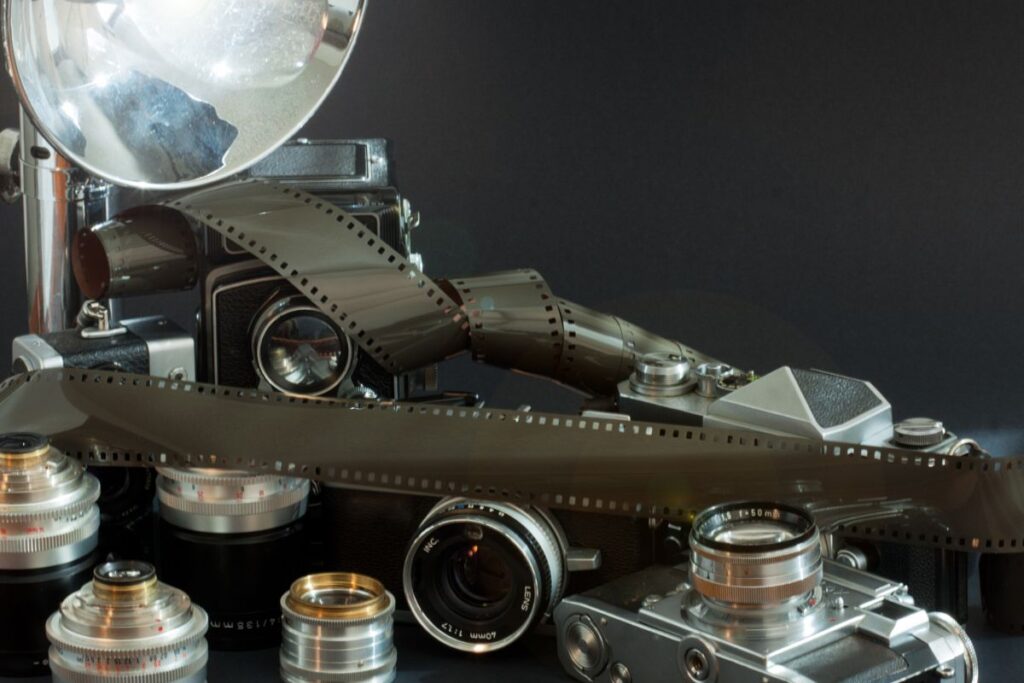Antique cameras are vintage photographic devices that were produced and used prior to the digital age. These cameras are typically defined as being at least 100 years old, although some collectors and enthusiasts may consider any camera that is no longer in production or is significantly older than current models to be an antique. Antique cameras may include a wide range of devices, from early box cameras and rangefinders to more modern SLR and medium format cameras. These cameras are prized for their unique character, charm, and quality craftsmanship, as well as their potential value as investments and collectibles.
The history of antique cameras dates back to the early 19th century, when the first photographic devices were invented. These early cameras were large, bulky, and required long exposure times, making it difficult to capture clear, detailed images. However, over time, camera technology improved, and smaller, more portable cameras were developed.
One of the first popular antique cameras was the box camera, which was introduced in the late 19th century and became widely available in the early 20th century. These simple cameras had a fixed focus lens and a simple shutter, and used film plates or roll film to capture images.
Rangefinder cameras, which used a system of mirrors and prisms to allow the photographer to focus the lens, were also popular in the early 20th century. Single lens reflex (SLR) cameras, which used a mirror and prism system to allow the photographer to see through the lens and focus the camera, were developed in the 1930s and became increasingly popular in the following decades.
Medium format cameras, which used larger film or digital sensors than 35mm cameras, were also developed in the 20th century and remain popular with some photographers today. Large format cameras, which use even larger film or digital sensors, are typically used for specialized applications such as architectural and landscape photography.
Antique cameras have continued to evolve and change over time, and today, collectors and enthusiasts can find a wide range of vintage cameras to suit their interests and needs.Regenerate response
Types of antique cameras
Box cameras

Box cameras are a type of antique camera that were popular in the late 19th and early 20th centuries. These simple, portable cameras were named for their box-like shape and were some of the first cameras to be widely available and affordable for the average consumer.
Box cameras typically had a fixed focus lens and a simple shutter, and used film plates or roll film to capture images. They were generally designed to be easy to use, with little or no adjustment required by the photographer.
Some popular box camera models include the Kodak Brownie, which was introduced in 1900 and became one of the most popular cameras of all time, and the Argus C3, which was produced from 1939 to 1966 and was known for its rugged construction and relatively high quality images.
While box cameras may seem primitive by today’s standards, they played a crucial role in the history of photography and helped to make photography more accessible to the general public. Today, box cameras are prized by collectors for their unique character and charm, as well as their potential value as antique items.
Rangefinder cameras

Rangefinder cameras are a type of antique camera that were popular in the early to mid-20th century. These cameras used a system of mirrors and prisms to allow the photographer to focus the lens, resulting in more accurate focusing than was possible with earlier box cameras.
Rangefinder cameras were typically more expensive and complex than box cameras, and were often used by professional photographers or serious amateurs. Some popular rangefinder camera models include the Leica M series, which was introduced in the 1950s and is still in production today, and the Contax II and III, which were produced in the 1930s and 1940s and are known for their high quality lenses and shutters.
Rangefinder cameras were eventually replaced by single lens reflex (SLR) cameras, which used a mirror and prism system to allow the photographer to see through the lens and focus the camera. However, many photographers still appreciate the simplicity and compact size of rangefinder cameras, and they continue to be popular with collectors and enthusiasts.
SLR cameras

Single lens reflex (SLR) cameras are a type of antique camera that were developed in the 1930s and became increasingly popular in the following decades. These cameras use a mirror and prism system to allow the photographer to see through the lens and focus the camera, resulting in more accurate and precise focusing than was possible with earlier rangefinder cameras.
SLR cameras are typically more expensive and complex than rangefinder cameras, and are often used by professional photographers or serious amateurs. Some popular SLR camera models include the Canon AE-1, which was introduced in the 1970s and became one of the most popular cameras of all time, and the Nikon F, which was produced from 1959 to 1974 and is known for its rugged construction and high quality optics.
SLR cameras have continued to evolve and change over time, and today, they are available in both film and digital versions. While SLR cameras may have been surpassed by newer camera technologies in some regards, they remain popular with many photographers and collectors due to their versatility, quality, and durability.
Medium format cameras

Medium format cameras are a type of antique camera that use larger film or digital sensors than 35mm cameras. These cameras are typically used by professional photographers or serious amateurs due to their higher image quality and larger film or digital negatives, which allow for larger prints or more detailed cropping.
Medium format cameras come in a variety of styles and designs, including rangefinder, single lens reflex (SLR), and twin lens reflex (TLR) models. Some popular medium format camera models include the Hasselblad 500 series, which was introduced in the 1950s and is known for its high quality lenses and rugged construction, and the Mamiya RB67, which was produced from 1970 to 1990 and is popular with studio and portrait photographers.
While medium format cameras may be more expensive and complex than smaller 35mm cameras, they are prized by many photographers for their superior image quality and flexibility. Today, medium format cameras are available in both film and digital versions and continue to be popular with professional photographers and collectors.
Large format cameras

Large format cameras are a type of antique camera that use even larger film or digital sensors than medium format cameras. These cameras are typically used for specialized applications such as architectural and landscape photography, due to their ability to capture high resolution, detailed images.
Large format cameras come in a variety of styles and designs, including monorail, field, and press models. Some popular large format camera models include the Linhof Technika, which has been in production since the 1930s and is known for its high quality construction and versatility, and the Sinar P, which was produced from the 1950s to the 1990s and is popular with studio and portrait photographers.
Large format cameras are typically more expensive and complex than smaller format cameras, and require more time and effort to use. However, many photographers appreciate the superior image quality and flexibility of large format cameras, and they continue to be popular with professional photographers and collectors.
Novelty cameras

Novelty cameras are a type of antique camera that were designed to be fun or unusual rather than purely functional. These cameras may be shaped like animals, vehicles, or other objects, and are often designed more for decoration or entertainment than for taking high quality photographs.
Some examples of novelty cameras include cameras shaped like cars, airplanes, animals, and other objects, as well as cameras that feature unusual designs or features such as cameras with multiple lenses or cameras that produce unique or distorted images.
Novelty cameras are typically less expensive and less sophisticated than more traditional cameras, and are often used as decorative or collectible items rather than as serious photographic equipment. Today, novelty cameras are popular with collectors and enthusiasts, and can be found at antique stores, online marketplaces, and other sources.
The appeal of antique cameras
Antique cameras are prized by collectors and enthusiasts for a number of reasons. Some of the main appeals of antique cameras include:
Unique character and charm: Antique cameras have a certain character and charm that cannot be found in modern cameras. Many antique cameras are works of art in their own right, with intricate designs, intricate mechanisms, and beautiful finishes.
Quality craftsmanship: Many antique cameras were made with high quality materials and attention to detail, resulting in durable, long-lasting devices. These cameras were often built to last, and many still function well today, even after decades or centuries of use.
Durability: In addition to being well-crafted, many antique cameras are also durable and resistant to wear and tear. This makes them a good investment for collectors, as they can be enjoyed and used for many years without the need for frequent repairs or maintenance.
Investment value: Antique cameras can also be a good investment, as the value of some antique cameras has increased significantly over time. Some rare or unusual antique cameras can fetch high prices at auctions or from collectors, making them a potentially lucrative investment.
Overall, the appeal of antique cameras lies in their unique character, charm, and quality craftsmanship, as well as their potential value as investments and collectibles.
Finding antique cameras
There are a number of ways to find antique cameras, depending on your interests and budget. Some options for finding antique cameras include:
Antique stores and dealers: Many antique stores and dealers specialize in vintage cameras, and can be a good source for finding antique cameras of all types and price ranges. These stores often have a wide selection of cameras, and can be a good place to browse and get an idea of what is available.
Auctions and estate sales: Auctions and estate sales can be a good source for finding antique cameras, as these events often feature a wide range of vintage items. However, it is important to do your research and be prepared to bid or negotiate for the cameras you are interested in, as prices can vary widely depending on the condition and rarity of the cameras.
Online marketplaces: Online marketplaces such as eBay and Etsy can be a good source for finding antique cameras, as they often feature a wide selection of vintage cameras from around the world. These marketplaces can be a convenient way to shop for antique cameras, but it is important to be careful and do your research before making a purchase, as some sellers may not be reputable or may not accurately represent the condition of their cameras.
finding antique cameras can be a fun and rewarding experience, and can provide a unique addition to your collection or decor.

Caring for antique cameras
Caring for antique cameras is important to ensure that these valuable and often fragile devices are preserved and protected. Some tips for caring for antique cameras include:
Handling and transportation: When handling antique cameras, it is important to be gentle and avoid rough or forceful movements. It is also a good idea to use padded cases or bags to protect the cameras when transporting them, to reduce the risk of damage from bumps or drops.
Cleaning and maintenance: Antique cameras should be cleaned and maintained regularly to keep them in good working order. This may include cleaning the lens, body, and other parts of the camera with a soft, dry cloth, and lubricating any moving parts as needed. It is also a good idea to protect the camera from dust, dirt, and moisture, as these can cause damage over time.
Repair and restoration: If an antique camera is damaged or not functioning properly, it may need to be repaired or restored by a professional. It is important to be careful when selecting a repair or restoration service, as some services may not have the necessary skills or experience to properly repair or restore antique cameras.
Insurance and storage: It is a good idea to insure antique cameras against damage or loss, as these valuable and often fragile devices can be expensive to replace. It is also important to store antique cameras in a safe, dry, and temperature-controlled environment to protect them from damage and deterioration.
caring for antique cameras requires a combination of careful handling, regular cleaning and maintenance, and proper storage and insurance to ensure that these valuable and often fragile devices are preserved and protected.
Antique cameras are a fascinating and rewarding area of collecting, offering a unique glimpse into the history of photography and the evolution of camera technology. These vintage cameras are prized for their unique character and charm, quality craftsmanship, and potential value as investments and collectibles.
There are many different types of antique cameras to choose from, ranging from simple box cameras to complex large format cameras, and collectors and enthusiasts can find a wide range of cameras to suit their interests and needs.
Finding and caring for antique cameras can be a fun and rewarding experience, and requires a combination of careful research, careful handling, and regular cleaning and maintenance to ensure that these valuable and often fragile devices are preserved and protected.
Whether you are a professional photographer, a serious amateur, or simply a collector or enthusiast, antique cameras can be a fascinating and rewarding hobby, and offer a unique window into the history of photography and the evolution of camera technology. So, antique cameras are a great addition to any collection.
Explore more vintage wonders in our collection: Antique Radio and Rare Antique Music Box.

Leave a Reply